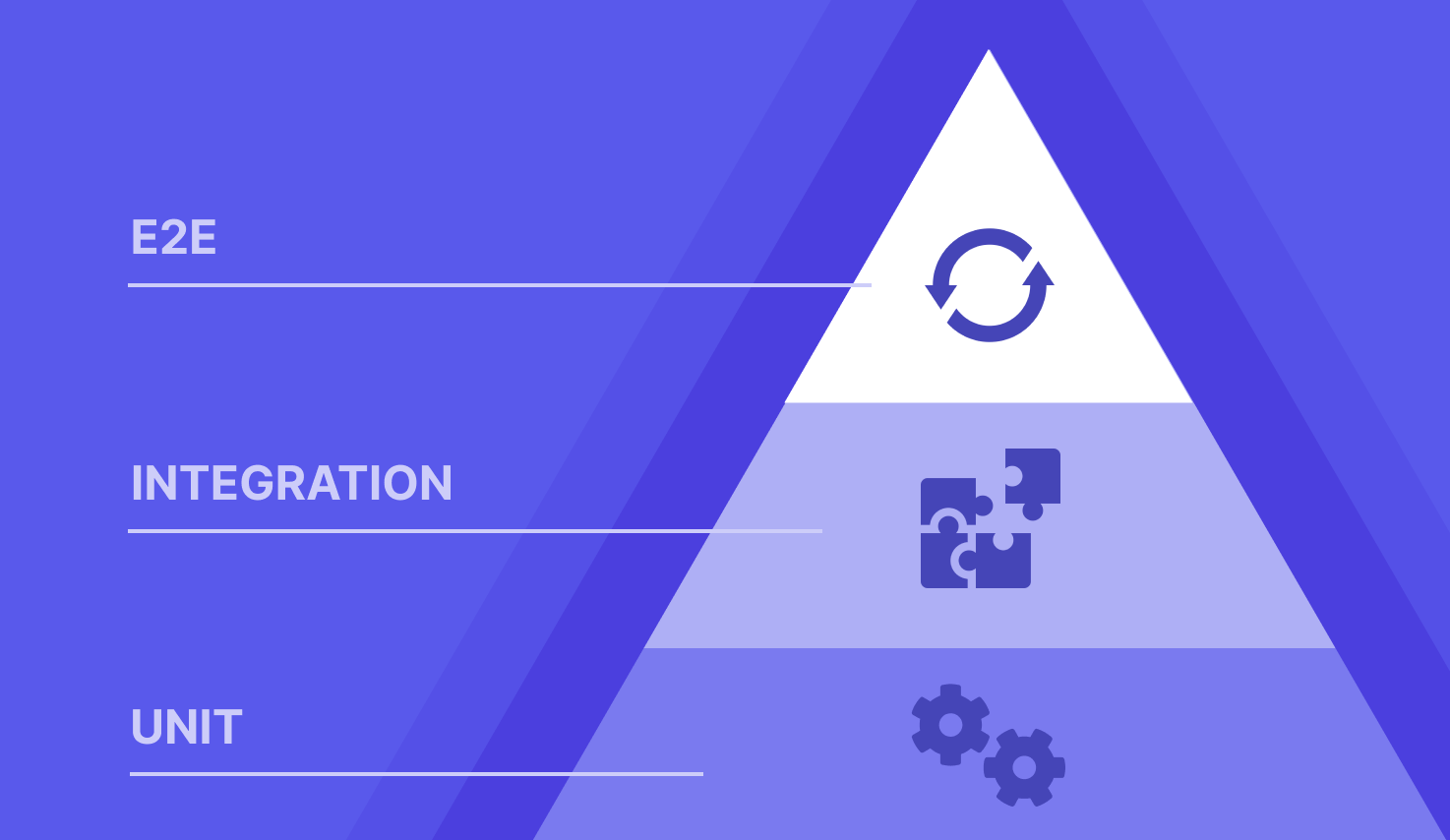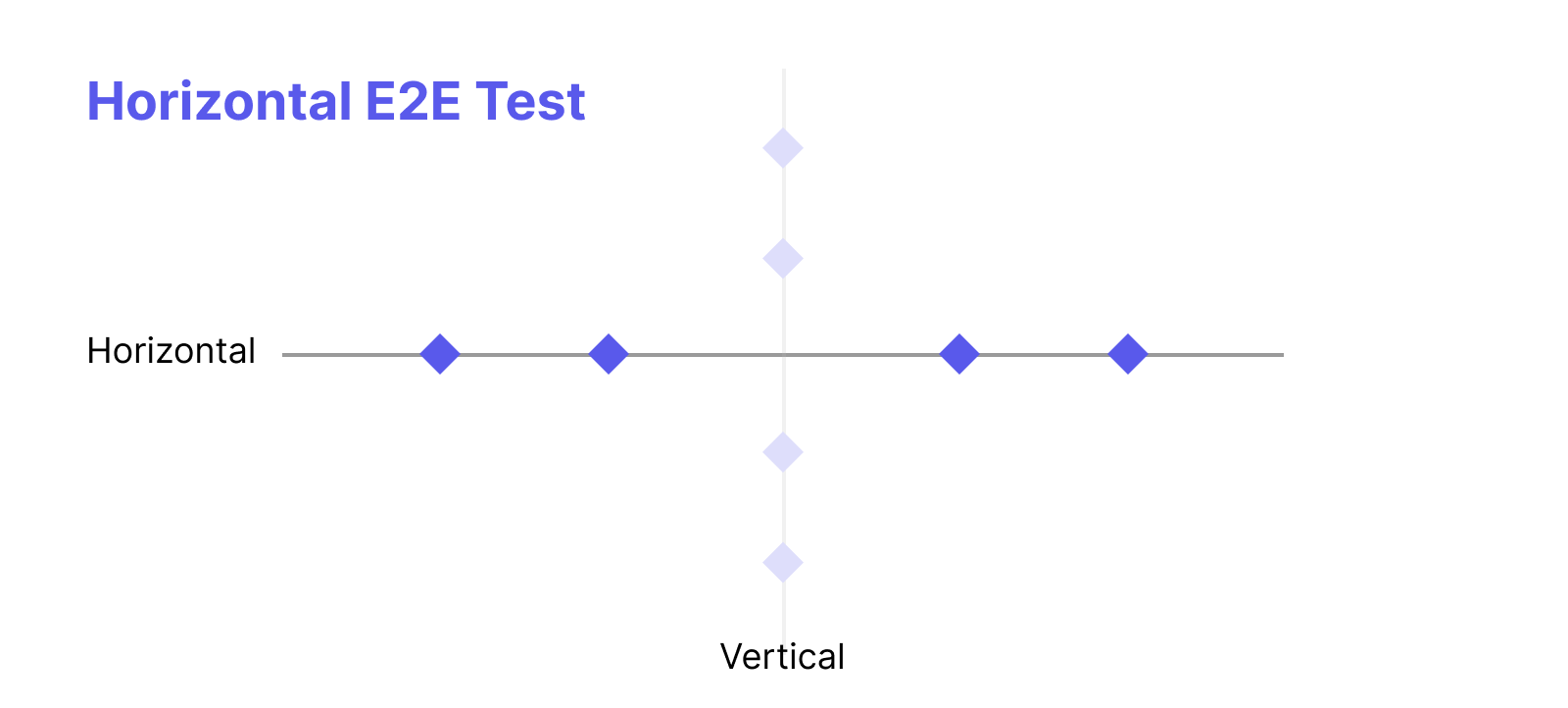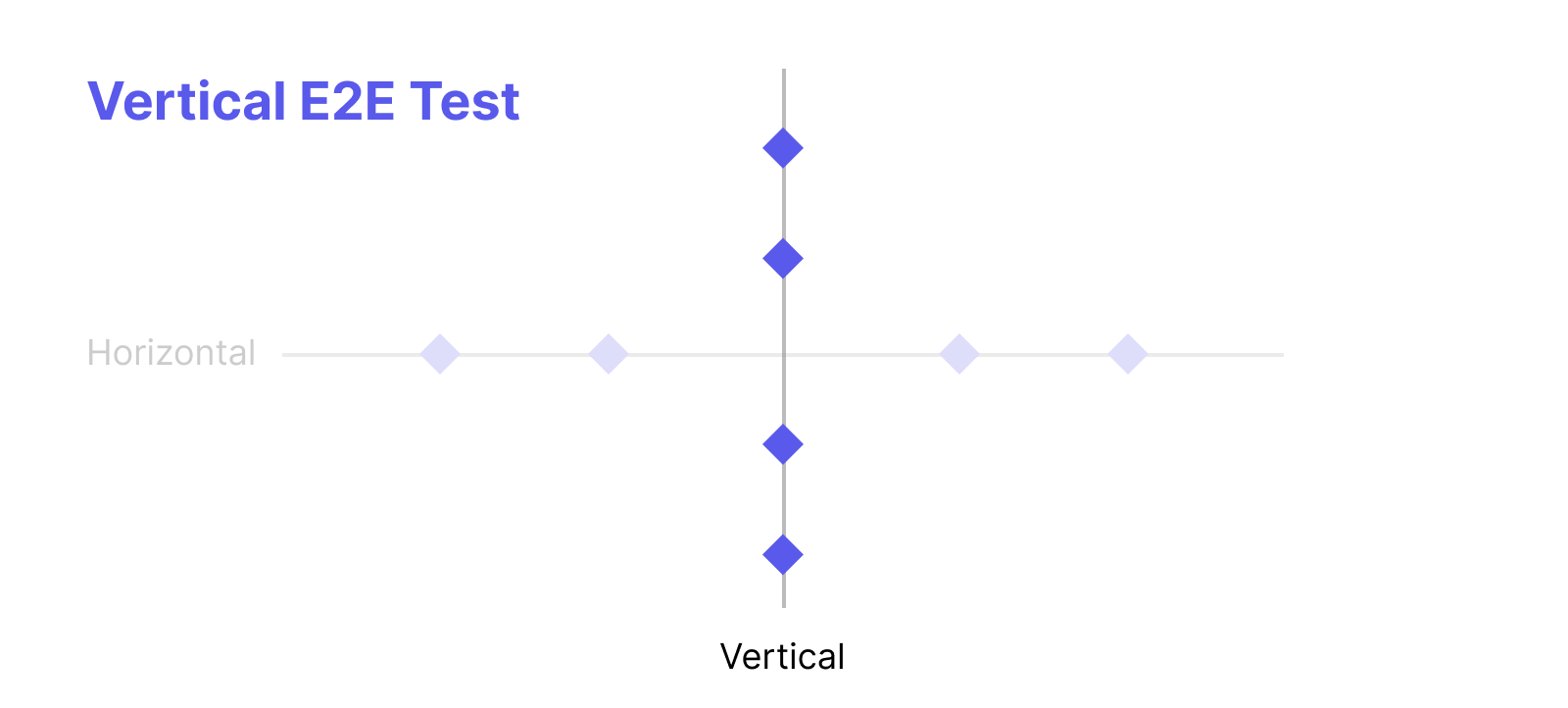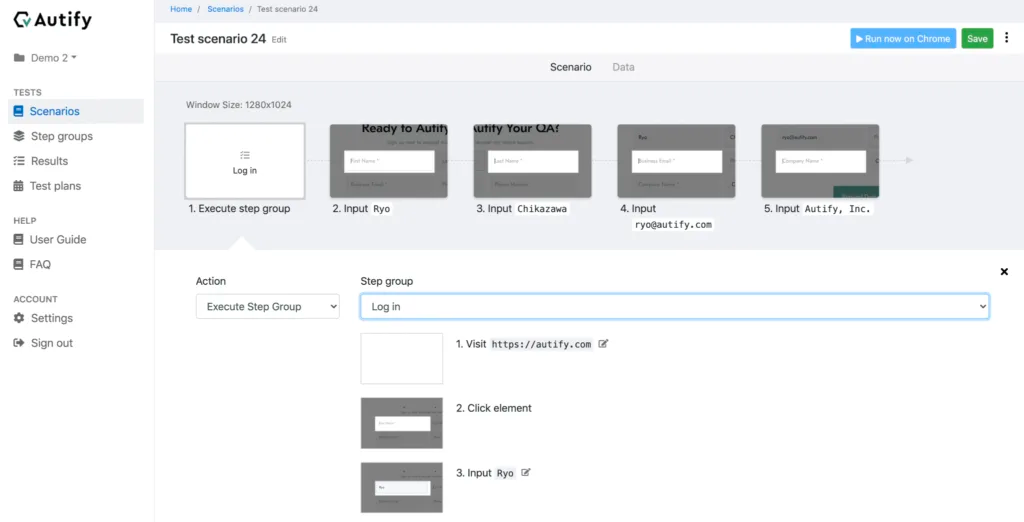What is End To End Testing? Definition, Tools, Best Practices
End-to-end testing (E2E testing) checks the system's behavior as a comprehensive whole. It's done after integration testing and before user acceptance testing to catch system-wide issues early.
Example of End To End Testing
Let’s take an example of an e-commerce website to understand E2E testing.
End-to-end testing here means testing all parts of the system—frontend, backend, database, and third-party services (payment, email)—work smoothly together. The full workflow to test is:
- Open Website
- Search for Product
- Select Product
- Add to Cart
- Checkout
- Enter Payment Details
- Place Order
- Receive Confirmation
- Admin Checks Order
- Track Order
When To Do End to End Tests?
Due to its scope, end-to-end test is usually done at the end of the process. Let's look at the test pyramid to see why:
A comprehensive test strategy should include 3 layers of tests:
- Unit tests (base of the pyramid): These tests focus on individual components, like functions or methods, ensuring that each small piece of the system works correctly in isolation.
- Integration tests (middle layer): Once individual components work, it’s time to check if they function properly together. Individual components that passed unit tests can totally break when they are integrated, usually due to data miscommunication. Integration tests ensure that data flows correctly between modules and that interfaces are solid.
- E2E tests/system tests (top of the pyramid): End-to-end tests validate the entire application, from the user interface to the back-end, ensuring the system works as a whole. These tests give high confidence in meeting business requirements, but they’re slower and more complex. Because of this, they should be limited to critical workflows to avoid flakiness.
As you can see, while unit testing is only concerned with ‘Is this specific module working well individually’, integration testing is concerned with ‘Are these modules working well together?’, the goal of end-to-end tests is much more comprehensive: is everything working well together?
In a good test strategy, E2E tests should only account for 5-10% of the total number of tests. This figure is around 15-20% for integration tests and 70-80% for unit tests.
Types of End to End Testing
1. Horizontal E2E test

Horizontal end to end testing is what the end user thinks of when they hear “end-to-end testing”. In this approach, testers focus on ensuring that each individual workflow in the application works correctly.
With horizontal end-to-end testing, QA professionals want to put themselves in the position of the user and test how they experience every customer-facing aspect of the application.
Read More: Manual Testing: A Comprehensive Guide
2. Vertical E2E test

Vertical E2E testing is a more technical approach. This is what the tester thinks when they hear end-to-end testing.
Unlike end users who only experience the frontend, testers also work with the backend, and they want to make sure that the right data is transferred to the right place, at the right time, so that all background processes keeping the application running can be smoothly executed.
Benefits of End To End Testing
End-to-end testing has been more reliable and widely adopted because of the following benefits:
-
Testing All Parts of the Application Together: Modern applications have multiple layers that must work smoothly as a whole. E2E testing ensures that these layers function correctly when connected.
-
Checking the Backend First: Since the database is crucial for the app, E2E testing verifies that it properly stores and shares data with other parts of the system.
-
Ensuring Consistency Across Devices and Browsers: E2E testing confirms that the app works well on different browsers, devices, and platforms. Cross-browser testing is often used to check this.
-
Testing Third-Party Integrations: Many apps rely on external services for specific tasks. E2E testing ensures these external systems work well with the app and share data correctly.
Challenges of End to End Testing
1. Complex Test Environment Setup
- E2E testing requires a staging environment that mirrors production.
- Setting up databases, APIs, third-party integrations, and dependencies can be time-consuming.
- Synchronizing test data across multiple services is difficult.
2. Test Flakiness and Instability
- End-to-end tests often fail due to network delays, UI changes, or dependencies on external systems.
- Dynamic elements (e.g., pop-ups, asynchronous calls) make tests unreliable.
- Intermittent failures make debugging difficult.
3. Slow Execution Time
- End-to-end tests cover the full application workflow, making them longer than unit or integration tests.
- Running tests across multiple browsers and devices increases execution time.
- Slow tests delay feedback loops in CI/CD pipelines.
How To Do End To End Testing?
1. Plan the Test Scenarios
- Identify key user actions (e.g., logging in, making a purchase, submitting a form).
- Consider different user roles and edge cases.
- List down the test cases in a test management system. Recommended test management tools include:
- Katalon TestOps: a comprehensive test management system, syncing with Katalon Studio where you can write automated tests with ease
- TestRail: a web-based test case management tool that integrates with Jira
- Xray: also a Jira-native test management tool that supports manual, automated, and exploratory testing
2. Set Up the Test Environment
- Use a staging environment that mimics the real system.
- Ensure databases, APIs, and integrations are working properly.
3. Choose the Right Testing Tools
- Use automation tools and frameworks like Katalon, Selenium, Cypress, for web apps.
- Use Appium for mobile apps.
4. Write and Execute Test Cases
- Create scripts or manually test each scenario step by step.
- Cover all components: frontend, backend, APIs, and databases.
Read More: How To Write a Test Case?
5. Validate the Results
- Check if the app behaves as expected at each step.
- Verify data integrity and system responses.
6. Debug and Fix Issues
- Identify failures, analyze logs, and fix defects.
- Retest after fixing issues to ensure stability.
- Craft a test report to show stakeholders.
7. Automate for Continuous Testing
- Run E2E tests automatically in CI/CD pipelines (e.g., GitHub Actions, Jenkins).
- Schedule regular test runs to catch issues early.
End To End Testing vs Integration Testing
Here is a comparison table for the differences between end-to-end testing and integration testing:
|
Aspect |
Integration Testing |
End-to-End Testing |
|
Perspective |
Technical team’s point of view |
Final user’s point of view |
|
Goal |
Ensure that application components work together |
Ensure that the User Experience is consistent |
|
Scope |
Multiple components within in one applications |
The scope may span across the entire technology stack of the application |
|
Cost |
Less expensive to implement |
More expensive to implement due to the hardware - software needed to best simulate real-world scenarios |
|
Time needed |
Faster than E2E testing (about less than 1 hour for 200 tests) |
Longer than Integration testing (may take up to 4 - 8 hours) |
Read More: End-to-end Testing vs Integration Testing
A quick example: let's say you have an application with the UI, API, and the backend.
The goal of E2E testing is to check the entire flow from the UI to the backend to the database.
The goal of integration testing is only to check the flow from the UI to the backend, or from the backend to the database.
In other words, the scope of integration testing is more limited than the scope of end-to-end testing.
Why run both? Integration tests are quicker to execute and provide faster, more targeted feedback. When they fail, it’s easier to pinpoint the issue since it’s isolated to specific components, excluding UI concerns. Test layers are designed to systematically narrow down potential problems in your codebase or configuration.
End-to-end Testing vs Functional Testing
Here is a comparison table to illustrate the differences between end-to-end testing vs functional testing:
|
Aspect |
Functional Tests |
End-to-End Tests |
|
Scope |
Testing is limited to one single piece of code or application. |
Testing crosses multiple applications and user groups. |
|
Goal |
Ensures the tested software meets acceptance criteria. |
Ensures a process continues to work after changes are made. |
|
Test Method |
Tests the way a single user engages with the application. |
Tests the way multiple users work across applications. |
|
What To Validate |
Validate the result of each test for inputs and outputs. |
Validate that each step in the process is completed. |
End-to-End Testing Success Metrics
Some of the many testing metrics used for E2E testing include:
1. Test Case Preparation Status
This metric tracks the percentage of test cases that have been prepared relative to the total number of planned test cases. It provides insights into the readiness of test cases before execution begins.
Formula:
Preparation Progress = (Number of Test Cases Prepared / Total Planned Test Cases) × 100
2. Test Progress Tracking
Metrics:
- Execution Progress: Measures the percentage of test cases executed relative to the total planned.
- Pass Percentage: Indicates the percentage of executed test cases that passed.
- Fail Percentage: Indicates the percentage of executed test cases that failed, providing insights into areas needing improvement.
Formulas:
Execution Progress = (Number of Executed Test Cases / Total Planned Test Cases) × 100
Pass Percentage = (Number of Executed Test Cases / Number of Passed Test Cases) × 100
Fail Percentage = (Number of Failed Test Cases / Number of Executed Test Cases) × 100
3. Defects Status and Details
Metrics:
- Open Defect Percentage: Measures the percentage of defects that are still unresolved.
- Closed Defect Percentage: Measures the percentage of defects that have been successfully resolved.
- Defect Distribution: Analyzes defects based on severity (critical, major, minor) and priority (high, medium, low), helping prioritize fixes.
Formulas:
Open Defect Percentage = (Number of Open DefectsTotal Defects) × 100
Open Defect Percentage = (Total Defects / Number of Open Defects) × 100
Closed Defect Percentage = (Total Defects / Number of Closed Defects) × 100
4. Environment Availability
It measures the availability of the testing environment compared to the scheduled operational hours. It ensures sufficient testing time and resource availability.
Formula:
Environment Uptime = (Actual Operational Hours / Scheduled Hours) × 100
End-to-End Testing Best Practices
1. Prioritize Critical Workflows
- Focus on the most important user flows first (e.g., login, checkout, payment).
- Break down complex workflows into smaller steps to streamline testing.
- Avoid unnecessary tests that do not add value.
2. Skip Exception Testing
- E2E testing is meant to validate full system workflows, not error handling.
- Use unit or integration testing to check how the system responds to errors.
- Avoid cluttering E2E tests with scenarios better suited for other test types.
3. Reduce UI Test Flakiness
- UI tests are prone to false failures due to network delays, loading times, or dynamic elements.
- Use smart wait strategies to ensure elements are fully loaded before interacting with them.
- Minimize reliance on UI tests by testing business logic through APIs when possible.
Read More: A Guide On UI Testing
4. Run Tests in Parallel
- Parallel execution speeds up testing, especially in CI/CD pipelines.
- Use cloud-based testing services for cross-browser and mobile testing.
- Prioritize tests based on risk and frequency of execution.
Top End to End Testing Tools and Frameworks
1. Katalon
Katalon is an excellent software quality management platform that can make your end-to-end tests a breeze.
With Katalon, QA teams can:
- Unify all testing activities (test planning, test authoring, test execution, test artifact management, to test analytics and reporting) in one platform
- Create automation tests for web, mobile, API and execute across a wide range of environment
- Receive AI-powered test case recommendations, generate synthetic test data, create test cases from plain language input, and auto-maintain flaky tests
2. Autify

Autify is a test automation tool designed for web and mobile applications. It allows users to automate E2E tests by recording interactions using its Chrome extension, then execute these tests across multiple platforms, including Windows, Linux, and Mac, as well as various web and mobile browsers. Its key features include:
- Smart Test Automation – Utilizes AI and machine learning to detect UI changes and adapt test cases automatically.
- Visual Test Editor – Enables test creation through a simple drag-and-drop interface.
- Seamless Integrations – Connects with CI/CD tools like CircleCI, Jenkins, and GitLab.
- Comprehensive Test Reporting – Provides detailed analytics, reports, and test execution logs with screenshots and video recordings.
3. testRigor

testRigor makes automated testing easy with simple plain commands, perfect for manual QA testers with little coding experience. Its AI-powered automation boosts test coverage with minimal effort. You can also create custom test cases for complex scenarios.
Key Features:
- Simulates real user interactions for accurate testing.
- Codeless cross-platform testing for web, native, and hybrid mobile apps.
- Integrates smoothly with test case management systems.
FAQs on E2E Testing
1. What is E2E testing, and why is it important?
E2E (End-to-End) testing verifies the entire application workflow from start to finish to ensure all components work together as expected. It is important because it simulates real user scenarios, catching issues that might be missed in unit or integration testing.
2. How is E2E testing different from integration testing?
Integration testing focuses on verifying the interaction between specific modules or components, while E2E testing validates the entire user journey, including front-end, back-end, and external systems like APIs or databases.
3. What tools are commonly used for E2E testing?
Popular tools include:
- Selenium
- Cypress
- Playwright
- TestCafe
- Puppeteer
These tools automate testing across various browsers and platforms to replicate user scenarios.
4. When should E2E testing be performed?
E2E testing is typically performed:
- After integration testing is complete.
- Before major releases to ensure the application works as expected.
- Regularly in CI/CD pipelines to validate workflows after changes or updates.
5. What challenges are associated with E2E testing?
- Setting up realistic test environments and data.
- Longer execution times compared to unit tests.
- Flaky tests caused by timing or environment inconsistencies.
- Maintaining tests when application changes frequently.
6. How can I ensure reliable E2E tests?
- Use stable test environments with consistent data.
- Avoid hardcoded delays; use dynamic waits (e.g., wait for elements to load).
- Write modular tests to improve maintainability.
- Regularly review and update test scripts to align with application updates.
7. Should E2E testing be automated or manual?
E2E testing can be both automated and manual:
- Automated E2E Testing: Ideal for repetitive workflows, regression testing, and validating functionality.
- Manual E2E Testing: Useful for exploratory testing and scenarios requiring human judgment.
8. How does E2E testing fit into a CI/CD pipeline?
E2E tests are integrated into CI/CD pipelines to validate the application after code changes or deployments. They help catch critical issues before they reach production, ensuring a smoother release process. However, only critical workflows are typically included to avoid slowing down the pipeline.





